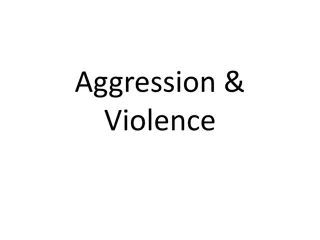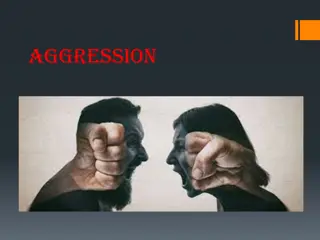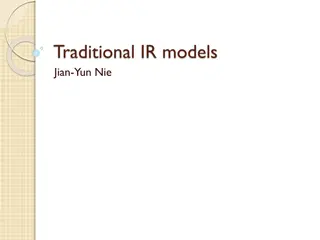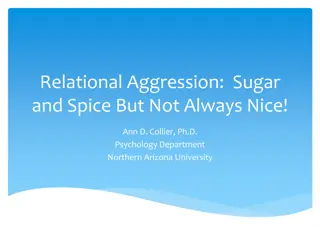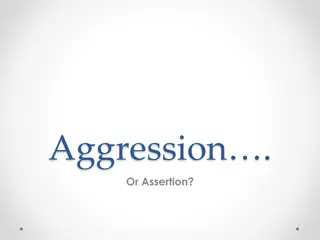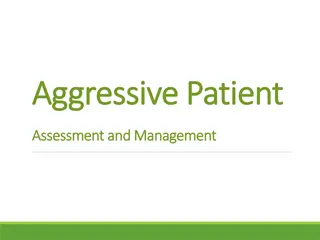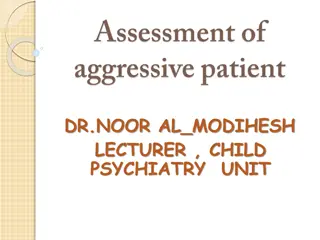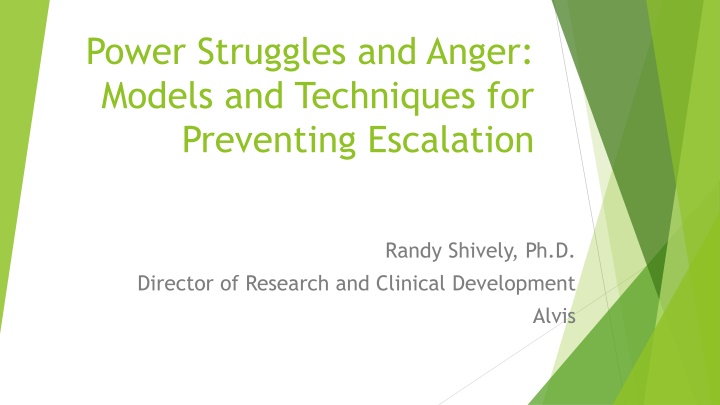
Preventing Escalation in High-Risk Client Situations: Expert Strategies
Discover expert techniques and models for preventing power struggles and managing anger effectively in high-risk client scenarios. Learn the impact of staff attitude on client interactions, explore strategies for developing a therapeutic culture, and understand successful approaches for fostering positive relationships. Avoid stress and burnout vulnerabilities while supporting clients with care and respect.
Download Presentation

Please find below an Image/Link to download the presentation.
The content on the website is provided AS IS for your information and personal use only. It may not be sold, licensed, or shared on other websites without obtaining consent from the author. If you encounter any issues during the download, it is possible that the publisher has removed the file from their server.
You are allowed to download the files provided on this website for personal or commercial use, subject to the condition that they are used lawfully. All files are the property of their respective owners.
The content on the website is provided AS IS for your information and personal use only. It may not be sold, licensed, or shared on other websites without obtaining consent from the author.
E N D
Presentation Transcript
Power Struggles and Anger: Models and Techniques for Preventing Escalation Randy Shively, Ph.D. Director of Research and Clinical Development Alvis
Referrals for Future High risk/ High Needs-ORAS- programming intensive Trauma histories- Abuse-physical, neglect, sexual Severe Mental Health Issues impulse issues, depression, thinking problems- C1, C2 status Authority Issues Histories of violence-multiple triggers- Domestic Violence, Disorderly Conduct, Rape, Aggravated ____
Discussion How does our attitude as staff affect clients? Is it what we say our how we say it? How many power struggles have you won with clients?
As staff what can you control? Not control? Your Behaviors------- Not others Behaviors Your Attitude------- Not others Attitude Your Respect------- Not others Respect All Are a Choice
Attitude Loop My Attitude affects- My Behavior -affects -Your Attitude- affects -Your Behavior- affects- My Attitude (Attitudes Interconnected) Change Your Attitude, Change My Attitude!
Need to Develop Therapeutic Culture - Active Treatment: Frequent meaningful interaction/teaching - Culture of learning: education shared betw staff and cls - Teachable Moments: informal learning opportunities - Building Therapeutic Relationships
Successful Approaches Consistency Positive Attitudes Quick, fair response to serious behaviors Never give up on client Look for ways to relate to them as a person Celebrate their successes
Stress and Burnout Make Staff Vulnerable Isolation is what the offender manipulator wants because isolated staff are easier to work on as part of the set-up. Isolation due to stress allows the offender to be the worker s support system and friend . Staff members isolated from positive support systems must talk to somebody, and offenders are only too glad to move right in and be their new support group Art of the Con, Gary Cornelius
Professionalism: Helps Minimize Power Struggles Know Alvis House code of conduct and follow it Know standard operating procedures of facility Be neat and well organized Never spread rumors or gossip about staff or clients Do not be drawn into discussion of unfair client conditions
Professionalism, contd Be very clear in communicating with clients No secrets- keep everything out in open If you don t know how to answer an offender s question, ASK! Make good use of written word take detailed notes when needed Do not accept any personal obligation toward a client
How staff respond is key I ve come to the frightening conclusion that I am the decisive element in the consumer s life. It s my personal approach that creates the climate; it s my daily mood that makes the weather. I possess a tremendous power to make a consumer s life miserable or joyous. I can be a tool of torture or an instrument of inspiration; I can humiliate or humor, hurt or heal. In all situations, it is my response that decides whether a crisis will be escalated or de-escalated and a consumer humanized or dehumanized Haim Ginott
In This Corner----------The Staff! The idea of having authority over clients is very important. The concern is if I do not have authority, the client will walk all over me and his behavior will get out of hand. I need to be empowered and have the control. My position gives me that right. Is this you?
In this Corner------------ The Client! The client wants to be their own person. They do not want to be told what they can or can not do. They want to make their own choices. They want to have the control to run their life. They do not want to be embarrassed in front of their peers. Is this your client?
Take Anger Quiz Scores are not meant as a diagnostic tool Scores not representative of a mental health disorder If you suspect you have a serious anger problem seek professional help and be careful with our clients Of Course you are Angry: A Guide to Dealing with the Emotions of Substance Abuse, by Gayle Rosellini and Mark Worden
Exploders and Stuffers: Unhealthy Anger Responses Exploders: pushing emotions outward; feeling good in the moment because you get the yuck/anger out; regrets of spewing on others; deflects regret by blaming others for our actions or shaming ourselves Stuffers: pushing emotions inward: pushing hurt feelings down and wallowing in our anger; either barriers are built up to keep people out or retaliation is planned Book: Unglued: Making Wise Choices in the Midst of Raw Emotions-Terkeurst-NY Times Bestseller
Teachable Moments Teachable moments are informal opportunities to engage and teach clients When did you last have a teachable moment? What gets in the way of these opportunities?
Staff Plan in any Confrontation with Client- Use in Role Plays Survey Environment- Who is nearby? Do I have an out? How upset is client? Do I have a plan if this escalates? Survey Self- What options can I give client? How upset am I? Do I need to do deep breathing to calm down? Do I need to take a break from the client? Do I need assistance with situation? Did I create a teachable moment for client? Take Action that is the least restrictive and least shaming and intrusive for client
Distance Self from Source of Anger and Slow your Breathing Distance Self- take a time out; tag team with another staff; find something to agree with if confrontation with client; put some physical distance between you and source of anger. Diaphragm Breathing- breath in through nose from belly button to 4 count; hold breath for 4 count; exhale through mouth slowly to 4 count.
Communication and Power Struggles Over 90% of Communication is related to Body Language and Tone of Voice. If staff s communication is perceived as negative, the client fails to hear the message! (See Handout)
Body Language Increases Power Struggles Standing too close to clients Pointing finger Standing over clients Blocking clients path Staring/laughing at clients Non approving looks- angry look
Examples of Body Language with Clients and Tone of Voice Randy s First Day at Witwer Hall- Assess Sex Offender What were my mistakes? What are your mistakes?
Consequences of Power Struggles Hurt Feelings Loss of Trust Rebellion Hostility, distancing-Grudge=GET EVEN!!! Escalation of anger-aggression= DANGER!!!
How to Prevent Power Struggles Know how to manage your own anger as staff Avoid the word NO or give reasons behind NO Create options for clients Focus on Client s strengths or need for support
How to Prevent Power Struggles, Contd Be Firm and Fair Be Consistent Provide Structure and Accountability Stop Talking and Listen
How to Prevent Power Struggles, Contd Remain Calm and Never show Fear Put your emotional energy into constructive solutions Be respectful and honest with clients Admit when you make a Mistake Use Humor when appropriate
How to Prevent Power Struggles, contd Create Teachable Moments Be Proactive and Aware of your Body Language Use Redirection as situations escalate Allow the client to save face Remember main goal of staff is SAFETY
Tone of Voice can be a Trigger: Is it what you say or how you say it? Harsh Parental Chastising ie.- You Can Not Go! Cold Disgusted
Personal Power Types Being right Winning Being fastest Being good or better Being successful
Clients create a lot of Personal Power Struggles Claims staff did or did not say or do something ( sure they are right) Says someone did something to them (sure it did not happen) Says he did not say or do something (evidence he did) Claims something is not what you think (you are sure it is)
How to respond to Personal Power struggles? Help the person win, succeed or be right -prior to escalation Clarification: be sure you are talking about the same thing Correct Client s Thinking: use Cognitive strategies (TOP, TOC, Create Options) Redirection: get client s focus on a desired topic or activity- for them
Is anger good or bad? What is good about anger? What is bad about anger? When does it get us in trouble with our clients? What have you learned about our clients anger?
The Escalation Spiral Agitation (raised voice, swearing) leads to: Intimidation (name calling, verbal threats)-- leads to: Violence (physical threats, assault) (Handout- Robert Morasky, 2006- Avoiding Power Struggles)
Prevent Escalation Once agitation sets in the client s brain stops reasoning and negative emotions engage (fight or flight)- Can t think and be agitated at same time Keep client at Discussion/Reasoning Step (thinking) or try and separate until emotions allow reasoning/thinking to return
What did you learn about----- Your Own Anger? Your Client s Anger? Staying Professional? Avoiding Conflict?
Contact Information Randy Shively, Ph.D., Director of Research and Clinical Development Alvis, Stella Ct., 614-252-8402. ext. 315 randy.shively@alvis180.org
References Avoiding Power Struggles- The Advance Challenging Behavior Series- Module 3- Robert L. Morasky, Ph.D. (November, 2006) Strategies for Better Mental Heath. 2003.Strategies for Anger Management. Reproducible Worksheets for Teens and Adults. Wellness Productions and Publishing (ISBN 10:1-893277-17-8), 1- 800-669-9208. Gulbenkoglu, H. and Hagiliassis, N. 2006. Anger Management: An Anger Management Training Package for Individuals with Disabilities. Jessica Kingsley Publishers: London and Philadelphia.
References, Contd Cornelius, G. 2009. Art of the Con: Avoiding Offender Manipulation, 2ndedition. Rosellini, G., and Worden, M. 1997. Of Course you are Angry: A Guide to Dealing with the Emotions of Substance Abuse Ringler, R. The 8 Most Effective De-escalation Techniques in Corrections ( Corrections1.com) Terkeurst, L. 2012. Unglued: Making Wise Choices in the Midst of Raw Emotions





